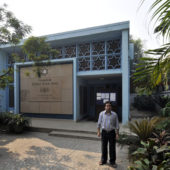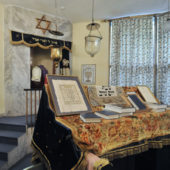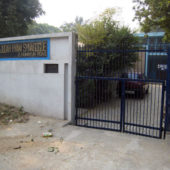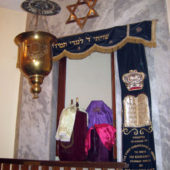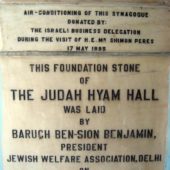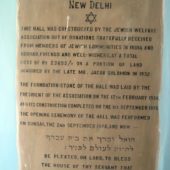The synagogue seves Delhi’s Jewish population of about 50 as well as diplomats and other visitors.
Interestingly, the Bene Israel Jews are the only sect of Judaism who have avoided anti-Semitism. Having lived harmoniously with their Indian neighbors for over 2,000 years, they have been free to worship and practice Judaism, and to live as a community. They have been fully included into Indian society, yet have still retained their “separateness.” The Bene Israeli claim to be direct descendents from the lost “ten tribes” of Israel. Biblical history relates that these ten tribes formed the Kingdom of Israel, which was exiled from their capital, Samaria, by the Assyrian King, Shalmaneser and subsequent kings from 722 BCE onwards. Other Bene Israeli believe that their ancestors escaped from Israel by sea in 175 BCE during the reign of Antiochus Epiphanes (prior to the events leading to Hannukah).
Legend recounts that on the sea voyage from Israel, to what is present day India, the forefathers of the Bene Israeli were shipwrecked and washed ashore the Konkan coast, south of Bombay. There were only fourteen survivors, seven women and seven men. They buried their dead near the village of Nawgaon, which later became the foundation of the first Bene Israel cemetery. The surviving Bene Israeli were offered to settle permanently in the Konkan villages. They adopted Hindu names similar to their first names, but added “-kar” onto their surnames, often indicating where they came from, for example: Penkar came from the village of Pen. Many Bene Israeli at that time became known as oil pressers. To outsiders, the Bene Israeli did not appear different to others, with the exception that they observed the Sabbath, celebrated major festivals, circumcised their sons and performed most of the prescribed Biblical offerings. Most of the prayers were forgotten, except for the “Shema Israel…” (Hear, O Israel…”).
When David Rahabi arrived, the Bene Israel came into contact with the other Jews. It is unclear as to whether he was an 18th century Cochin Jew, or whether the Bene Israel tradition that records his arrival as far back as 1,000 CE is correct. Either way, he was a Cochin Jew that helped promote unity between all Indian Jews. He allegedly inspired them to begin celebrating Shavuot, Sukkoth, as well as, more minor feasts and fasts, which they had not been observing prior to their relationship with him. By the 19th century, Cochin Jews were involved in training the Bene Israel religious leadership: teachers, cantors and ritual slaughterers.
In 1745 the Divekar family, were the first Bene Israel family to settle in Bombay, where religious freedom was ensured by the British. Their five sons were employed by the East India Trading Company. In 1796, additional Bene Israel families followed the Divekar family and moved to Bombay. By the end of the 19th century, the Bene Israel workers in Bombay were performing white-collar work, and employed as doctors, lawyers, writers, architects, professors, teachers, nurses, secretaries, social workers, civil servants and skilled workers in factories and workshops. Bene Israel families began to emigrate from as far as Burma and Aden to Bombay. The Bene Israel population grew from 6,000 in the 1830s to 10,000 by the turn of the century. In 1948 there were 20,000 Bene Israel in India; however, this number decreased to 16,000 as a result of many of them emigrating to Israel. Today, there are less than 5,000 Jews in India, most of whom are Bene Israel, due to further numbers emigrating not only to Israel, but also to the United States, Britain, Canada and Australia. Today, over 60,000 Bene Israel live in Israel.
To cater to the growing religious, social and cultural needs of the Bene Israel in Delhi, the Jewish Welfare Association was formed in 1949. They felt the need of a prayer hall for the community and funds were raised. The foundation stone of Judah Hyam Hall was laid on February 12, 1956 and the Synagogue was completed on September 2, 1956. An annex was constructed in 1979, which was to be used as a library stocked with books from all faiths and an interfaith study center, with the aim of promoting goodwill between religions. Today, there are seven or eight families (approximately forty people) who worship at the Synagogue, as well as diplomats from Embassies, High Commissions, business people and tourists. Regular Sabbath and High Holiday services are held, as well as Bar and Bat-Mitzvahs.
Judah Hyam Hall is rather extraordinary in that its Rabbi has never been ordained and it bends ancient customs, opening its doors to people of all faiths and allowing women to count in comprising its ten “people,” not just “men” to make up a minyan (prayer/religious service). In fact, the Rabbi is hoping that his daughter will follow him and fill his shoes one day and become Rabbi of the congregation. The Rabbi’s unorthodox ways have ensured that the small congregation has survived.
During High Holidays and winter, the tourist period, there are more visitors to the Synagogue. There can be up to 10,000 international visitors to the Synagogue during tourist season. The core community of the Synagogue shares a special bond and relate to each other as a family. After the 2008 Mumbai attacks and more recently after Osama bin Laden was killed, the government posted paramilitary soldiers outside the Synagogue. The members are grateful that India has not suffered from anti-Semitism. The Indian Jews have a deep love for India and their Jewish heritage. They are working to keep both alive.
The exterior of Judah Hyam Hall is a powder blue stucco façade with outlines of Stars-of David across the top and above the entrance. The interior speaks of an elegance of time past. The prayer room is purpose-built with yellow walls. Attractive dark wood chairs with Stars-of-David carved out of the backs and elegantly scrolled arms sit on blue carpeting. The bimah is situated in the center of the prayer room, slightly elevated and surrounded with dark wood turned wood balusters and handrails. The tivah (reader’s desk) is inside the bimah, and elegant heavy royal blue throws with gold embroidery are draped inside and over the bimah. Unusually, the Aron Kodesh is placed in the corner, carved out of simple gray marble. A Star-of-David adorns the top, as well as a royal blue pelmet and Torah curtain with Hebrew scriptures in gold embroidery and tassels. Chandeliers light the room, a brass incense burner drops down in front of the Aron Kodesh and there are also ceiling fans to keep the congregants cool. Adjacent to the synagogue, out of doors, there is a cemetery.

